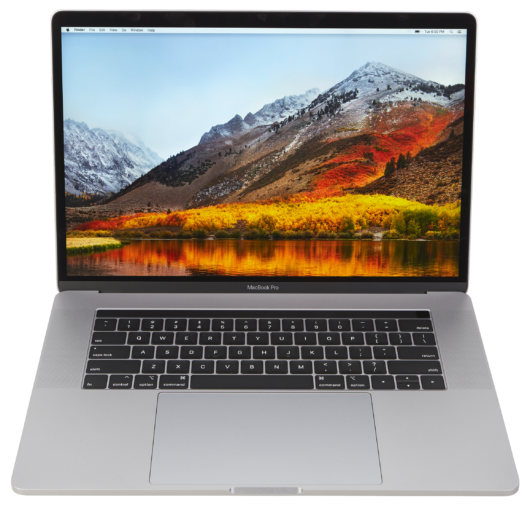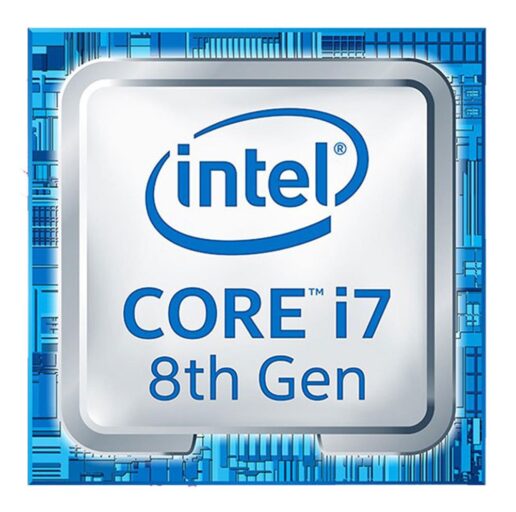 With the release of 8th-Gen Intel CPUs, the 2018 MacBook Pro was leaps and bounds faster than any generation before it. For the same base price as last year’s ($2399) base model, you now have an entire 2 extra cores with 4 extra threads, and is the first ‘Book with DDR4. A slightly updated butterfly keyboard comes along too, with silicon underneath the keycaps to address the keyboard issues in 2016/17. Apple also addressed the “flexgate” issue in the 2018 model – an issue affecting 2016/17 models where the display cable was too short, fraying over time and causing display issues. The base model also doubles the amount of VRAM over last year’s model, starting at 4 GB.
With the release of 8th-Gen Intel CPUs, the 2018 MacBook Pro was leaps and bounds faster than any generation before it. For the same base price as last year’s ($2399) base model, you now have an entire 2 extra cores with 4 extra threads, and is the first ‘Book with DDR4. A slightly updated butterfly keyboard comes along too, with silicon underneath the keycaps to address the keyboard issues in 2016/17. Apple also addressed the “flexgate” issue in the 2018 model – an issue affecting 2016/17 models where the display cable was too short, fraying over time and causing display issues. The base model also doubles the amount of VRAM over last year’s model, starting at 4 GB.
Butterfly Keyboard Issues
The main deal comes down to the way the butterfly keyboard is designed in and of itself. The hinge in the middle that holds together the two keyboard switch parts, allows a lot of gunk to get into it. Then, the key gets stuck, could repeat-type the same character, or just stop working altogether. In a world of computers, this was and still is a bit of a race car. But like a race car, some of these had to be rebuilt. The 2018 MacBook Pro remedies this somewhat by adding a silicon membrane under each keycap. Despite this, the issue persisted albeit to a lesser degree.
Thin chassis and thermal dynamics
 Indeed this body style was the thinnest MacBook Pro at the time, coming in at 15.5mm, only 4.5mm thicker than an M1 iMac. The chassis was not the most suitable for the type of heat output the CPUs and GPUs were giving. The first thing you’d wanna install is Macs Fan Control. This was a very fast computer to use in 2018 (especially over the ’17), and some heavy-ish games would run on here, but my recommendation – treat it like a Titanium PowerBook G4, air-dust the keyboard twice daily, and keep the original box if you can.
Indeed this body style was the thinnest MacBook Pro at the time, coming in at 15.5mm, only 4.5mm thicker than an M1 iMac. The chassis was not the most suitable for the type of heat output the CPUs and GPUs were giving. The first thing you’d wanna install is Macs Fan Control. This was a very fast computer to use in 2018 (especially over the ’17), and some heavy-ish games would run on here, but my recommendation – treat it like a Titanium PowerBook G4, air-dust the keyboard twice daily, and keep the original box if you can.
Integrated (i)GPU + Dedicated (d)GPU
The Intel UHD/HD line of Integrated Graphics continue trend of “vampire video” (that’s where the video bites into system memory). The 2006 Mac mini was the first Mac in a long, long time to do this, and more Macs started doing this in the late 2000’s – early 2010’s. The dedicated AMD GPU (dGPU) does not share its VRAM with the rest of the system, nor does it pull from the RAM.
HBM Memory (Radeon Pro Vega 16/20)
HBM memory is implemented in a 3D stacked configuration, where multiple DRAM (Dynamic RAM) layers are stacked vertically, with each layer connected using Through-Silicon Vias (TSVs) directly on the GPU die rather than on the card PCB. This results in less space taken, higher memory bandwidth, and overall better power efficiency. Most apps won’t saturate the bandwidth offered by HBM, but it’s here in the 2018 MacBook Pro as a configurable option.
Closed Lid Mode: All Intel ‘Books support “lid closed” (or clamshell) mode, which leaves the built-in display off and dedicates all video RAM to an external display. To used closed lid mode, your ‘Book must be plugged into the AC adapter and connected to an external display and a USB or Bluetooth mouse and keyboard (you might also want to consider external speakers). Power up your ‘Book until the desktop appears on the external display and then close the lid. Your ‘Book will go to sleep, but you can wake it by moving the mouse or using the keyboard. The built-in display will remain off, and the external monitor will become your only display.
To resume use of the internal display, you need to disconnect the external display, put the computer to sleep, and then open the lid. This will wake up your ‘Book and restore use of the built-in display.
Battery life is claimed to be 10 hours of wireless productivity.
Details
- Announced July 12th, 2018
- Apple model number: A1990 (EMC 3215)
- Model ID: MacBookPro15,1
- Order: MR932LL/A* (Space Gray, Base i7)
- MR962LL/A. (Silver, Base i7)
- MR942LL/A (2.6 i7 SG)
- MR972LL/A. (2.6 i7 Silver)
- BTO/CTO: 2.9 i9
- Discontinued May 21st 2019
Mac OS
- Requires macOS 10.13.6 (17G2112) High Sierra or later.
Core System
All CPU options are Hexa-Core, Hyper Threaded, 14nm Coffee Lake CPUs.
- 2.2 Ghz Intel Core i7-8750H ($2399), 45w TDP
- 192k L1D, 192K L1i, 1.53 MB L2, 9 MB L3, Turbo Boost to 4.1 Ghz
- 2.6 Ghz Intel Core i7-8850H ($2799),
- 192k L1D, 192K L1i, 1.53 MB L2, 9 MB L3, Turbo Boost to 4.3 Ghz
- 2.9 Ghz Intel Core i9-8950HK (+$300) option,
- 192k L1D, 192K L1i, 1.53 MB L2, 12 MB L3, Turbo Boost to 4.8 Ghz
Memory
- 16 GB 2400 MHz PC4-19200 LPDDR4 SDRAM, soldiered onboard.
- Configurable to: 32 GB
Video
- All models shipped standard with Intel UHD 630 1536 MB GPU, 350 MHz – 1.1 Ghz
- AMD Radeon Pro 555X 4 GB GDDR5
- Configurable to: AMD Radeon Pro 560X 4 GB GDDR5
- Radeon Pro Vega 16 w/4 GB HBM2, or Radeon Pro Vega 20 w/4 GB HBM2
- 15.4″ 2880 x 1800 LED-backlit TFT LCD IPS Retina display, 220 ppi
- Support for millions of colors
- 500 nits brightness max
- Wide Color (P3)
- Support for native display resolution while also plugging in:
- Up to 2x 5120 x 2880 @60Hz w/over a Billion colors
- Up to 4x 4096 x 2304 @60 Hz w/Millions of colors
- Up to 4x 4K60 w/over a Billion colors
Drives
- 256 GB PCIe SSD (Base model)
- 512GB (+$200), 1TB (+$600), 2 TB (+$1400), 4 TB (+$3400) This is not a typo.
- 512 GB PCIe SSD 2.6 i7/2.9 i9
- 1TB (+$400), 2 TB (+$1200), 4 TB (+$3200)
- 1TB (+$400), 2 TB (+$1200), 4 TB (+$3200)
Expansion
- Thunderbolt 3: 4x USB-C ports, up to 40 Gb/s
- Support for USB 3.1 Gen 2, up to 10 Gb/s
- FireWire 400: optional via Thunderbolt adapter
- FireWire 800: optional via Thunderbolt adapter
- Ethernet: optional via Thunderbolt adapter
- WiFi: 802.11ac AirPort Extreme built in
- Modem: No longer offered by Apple
- Bluetooth: BT 4.2 built in
- ExpressCard/34: none
- SD Card Slot: none
- expansions bays: none
- IR receiver: none
- webcam: FaceTime 720p HD camera
- Three Microphones





